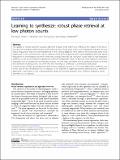| dc.contributor.author | Deng, Mo | |
| dc.contributor.author | Li, Shuai | |
| dc.contributor.author | Goy, Alexandre | |
| dc.contributor.author | Kang, Iksung | |
| dc.contributor.author | Barbastathis, George | |
| dc.date.accessioned | 2020-06-30T22:04:43Z | |
| dc.date.available | 2020-06-30T22:04:43Z | |
| dc.date.issued | 2020-03 | |
| dc.date.submitted | 2019-08 | |
| dc.identifier.issn | 2047-7538 | |
| dc.identifier.uri | https://hdl.handle.net/1721.1/126034 | |
| dc.description.abstract | The quality of inverse problem solutions obtained through deep learning is limited by the nature of the priors learned from examples presented during the training phase. Particularly in the case of quantitative phase retrieval, spatial frequencies that are underrepresented in the training database, most often at the high band, tend to be suppressed in the reconstruction. Ad hoc solutions have been proposed, such as pre-amplifying the high spatial frequencies in the examples; however, while that strategy improves the resolution, it also leads to high-frequency artefacts, as well as low-frequency distortions in the reconstructions. Here, we present a new approach that learns separately how to handle the two frequency bands, low and high, and learns how to synthesize these two bands into full-band reconstructions. We show that this “learning to synthesize” (LS) method yields phase reconstructions of high spatial resolution and without artefacts and that it is resilient to high-noise conditions, e.g., in the case of very low photon flux. In addition to the problem of quantitative phase retrieval, the LS method is applicable, in principle, to any inverse problem where the forward operator treats different frequency bands unevenly, i.e., is ill-posed. ©2020, The Author(s) | en_US |
| dc.description.sponsorship | Intelligence Advanced Research Projects Activity (IARPA) grant (No. FA8650-17-C-9113) | en_US |
| dc.language.iso | en | |
| dc.publisher | Springer Science and Business Media LLC | en_US |
| dc.relation.isversionof | https://dx.doi.org/10.1038/s41377-020-0267-2 | en_US |
| dc.rights | Creative Commons Attribution 4.0 International license | en_US |
| dc.rights.uri | https://creativecommons.org/licenses/by/4.0/ | en_US |
| dc.source | Nature | en_US |
| dc.title | Learning to synthesize: robust phase retrieval at low photon counts | en_US |
| dc.type | Article | en_US |
| dc.identifier.citation | Deng, Mo et al., "Learning to synthesize: robust phase retrieval at low photon counts." Light: Science and Applications 9 (March 2020): no. 36 doi. 10.1038/s41377-020-0267-2 ©2020 | en_US |
| dc.contributor.department | Massachusetts Institute of Technology. Department of Electrical Engineering and Computer Science | en_US |
| dc.contributor.department | Massachusetts Institute of Technology. Department of Mechanical Engineering | en_US |
| dc.contributor.department | Singapore-MIT Alliance in Research and Technology (SMART) | en_US |
| dc.relation.journal | Light: Science and Applications | en_US |
| dc.eprint.version | Final published version | en_US |
| dc.type.uri | http://purl.org/eprint/type/JournalArticle | en_US |
| eprint.status | http://purl.org/eprint/status/PeerReviewed | en_US |
| dc.date.updated | 2020-06-22T19:07:32Z | |
| dspace.date.submission | 2020-06-22T19:07:35Z | |
| mit.journal.volume | 9 | en_US |
| mit.journal.issue | 1 | en_US |
| mit.license | PUBLISHER_CC | |
| mit.metadata.status | Complete | |
